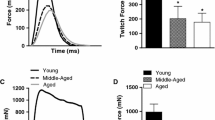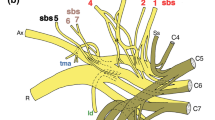Summary
-
1.
The effect of denervating the hemidiaphragm of the quokka (Setonyx brachyurus), hamster, guinea pig and bat (Myotis pallidus) was determined. The hemidiaphragm of the quokka neither hypertrophied nor atrophied during the period of 171 days (Fig. 1). The hemidiaphragm of the hamster exhibited a slight hypertrophy, about 5%, during the first week and by 28 days atrophy of 13% had occurred (Fig. 2). The hemidiaphragm of the guinea pig exhibited no hypertrophy but by 30–35 days atrophy of 15% had occurred (Fig. 3). In the bat levels of hypertrophy to 30% occurred but the average during the first 2 weeks was only 8%. Atrophy of 9.5% had occurred by 3 weeks (Fig. 4A).
-
2.
Bats kept at 2–3° C or 10° C after denervation of the hemidiaphragm exhibited average extents of hypertrophy comparable to that occurring at room temperature (Fig. 4 B).
-
3.
Various limb muscles were denervated for comparison. The biceps brachii muscles of the quokka atrophied 15% by 2 weeks and 35% by 35 days (Fig. 1). The gastrocnemius-soleus muscles of the hamster had atrophied 40% by 14 days, 55% by 28 days, while the plantaris muscle atrophied more slowly, 31% and 46% by 14 and 28 days respectively (Fig. 2). The major wing extensors of the forearm, the extensor carpi radialis longus and extensor carpi radialis brevis, exhibited a significant hypertrophy in the bat averaging 4.3% during the first 24 days (Fig. 5). No atrophy occurred during a period up to 42 days. These muscles are maintained in the extended position by folding of the wing after denervation.
-
4.
The report of Gutmann (1960) that hypertrophy of the anterior tibial muscle of the rat occurred during the first 24 hours after denervation as evidenced by an increase in non collagenous protein nitrogen was not confirmed. No increase in this component or in wet or dry weight was observed (Table 2).
-
5.
The report of Feng et al. (1962) that hypertrophy of the anterior latissimus dorsi and atrophy of the posterior latissimus dorsi of the chicken occurs after denervation was confirmed. The teres minor of the chicken, which is stretched by drooping of the wing after denervation, exhibited hypertrophies to 62% during the first 30 days. Atrophy was not observed (Fig. 6).
-
6.
The anterior latissimus dorsi of the pigeon exhibited increases in dry weight to 43% during the first month after denervation. The deltoideus major, deltoideus minor, and scapulotriceps of the pigeon exhibited atrophies of 45% by 20–23 days (Fig. 7). When the wings of the pigeon were supported by a cast atrophy of the denervated anterior latissimus dorsi occurred, reaching 38% by 18–20 days (Fig. 8).
Similar content being viewed by others
References
Ballentine, R., Gregg, J.: Micro-Kjeldahl determination of nitrogen. Analyt. Chem. 19, 281–283 (1947).
Chang, C., Feng, T. P.: Comparative study of the protein and nucleic acid changes of the anterior and posterior latissimus dorsi muscles of the chick following denervation. Acta physiol. Sinica 25, 312–319 (1962).
Feng, T. P.: The effect of length on the resting metabolism of muscle. J. Physiol. (Lond.) 74, 441–454 (1932).
—, Jung, H. W., Wu, W. Y.: The contrasting trophic changes of the anterior and posterior latissimus dorsi of the chick following denervation. Acta physiol. Sinica 25, 304–311 (1962).
— — —: The contrasting trophic changes of the anterior and posterior latissimus dorsi of the chick following denervation. In: The Effect of Use and Disuse on Neuromuscular Functions, edit, by E. Gutmann and P. Hnik. Amsterdam-London-New York: Elsevier Pub. Co. 1965.
—, Da-xing, Lu: New lights on the phenomenon of transient hypertrophy in the denervated hemidiaphragm of the rat. Sci. Sinica 14, 1772–1784 (1965).
Gates, W. H.: Keeping bats in captivity. J. Mammal. 17, 268–273 (1936).
George, J. C., Susheela, A. K.: A histophysiological study of the rat diaphragm. Biol. Bull. 121, 471–480 (1961).
Gornall, A. G., Bardawill, C. J., David, M. M.: Determination of serum proteins by means of the biuret reaction. J. biol. Chem. 177, 751–766 (1949).
Gutmann, E.: “Denervation hypertrophy”-the first stage in the course of denerration changes in muscle. Physiol. bohemoslow. 9, 382–389 (1960).
Hock, R. J.: The metabolic rates and body temperature of bats. Biol. Bull. 101, 289–299 (1951).
Jirmanova, I., Zelena, J.: Effect of denervation and tenotomy on slow and fast muscles of the chicken. Z. Zellforsch. 106, 333–347 (1970).
Knowlton, G. C., Hines, H. M.: Kinetics of muscle atrophy in different species. Proc. Soc. exp. Biol. (N.Y.) 35, 394–398 (1936).
Krüger, P.: Tetanus und Tonus der quergestreiften Skelettmuskeln der Wirbeltiere und des Menschen. Leipzig: Akad. Verlag. 1952.
Martin, A. W., Sola, O. M.: The rate of atrophy of rat diaphragm. Fed. Proc. 7, 78 (1948).
Miledi, R., Slater, C. R.: Electron-microscopic structure of denervated skeletal muscle. Proc. roy. Soc. B 174, 253–269 (1969).
Sola, O. M., Martin, A. W.: Denervation hypertrophy and atrophy of the hemidiaphragm of the rat. Amer. J. Physiol. 172, 324–332 (1953).
Stewart, D. M.: Changes in the protein composition of muscles of the rat in hypertrophy and atrophy. Biochem. J. 59, 553–558 (1955).
—: Effect of age on the response of four muscles of the rat to denervation. Amer. J. Physiol. 214, 1139–1146 (1968).
—, Martin, A. W.: Hypertrophy of the denervated hemidiaphragm. Amer. J. Physiol. 186, 497–500 (1956).
Vaughan, T. A.: Functional Morphology of three bats. Eumops, Myotis, Macrotus. Univ. Kansas Publ. Museum of Natural History 12, 1–153 (1959).
Wehrmacher, W. H., Thomson, J. D., Hines, H. M.: Effects of electrical stimulation on denervated skeletal muscle. Arch. phys. Med. 26, 261–266 (1945).
Wright, G. P.: Introduction to pathology. London: Longmans, Green & Co. Ltd. 1958.
Zak, R., Gutmann, E., Vrbova, G.: Quantitative changes in muscle proteins following direct stimulation of muscle. Physiol. bohemoslov. 6, 309–315 (1957).
Author information
Authors and Affiliations
Additional information
This study was supported by Grant NB 05294 of the National Institutes of Health, by Grant GB 17539 of the National Science Foundation, by funds from the Institutional Research Grant to the University from the American Cancer Society, and by NSF Institutional Grant of 1968 to the University of Washington.
We thank Dr. Philip Leitner, St. Mary's College, California for supplying the bats used in this study.
Quokkas were investigated at the laboratories of the University of Western Australia, at Perth, through the kindness of Professor H. Waring. The animals were captured on the Rottnest Island Reserve by Mr. Thomas L. Riggert, who also assisted with maintenance and dissection. We here express our appreciation for the many courtesies enjoyed.
Rights and permissions
About this article
Cite this article
Stewart, D.M., Sola, O.M. & Martin, A.W. Hypertrophy as a response to denervation in skeletal muscle. Z. Vergl. Physiol. 76, 146–167 (1972). https://doi.org/10.1007/BF00455959
Received:
Issue Date:
DOI: https://doi.org/10.1007/BF00455959




